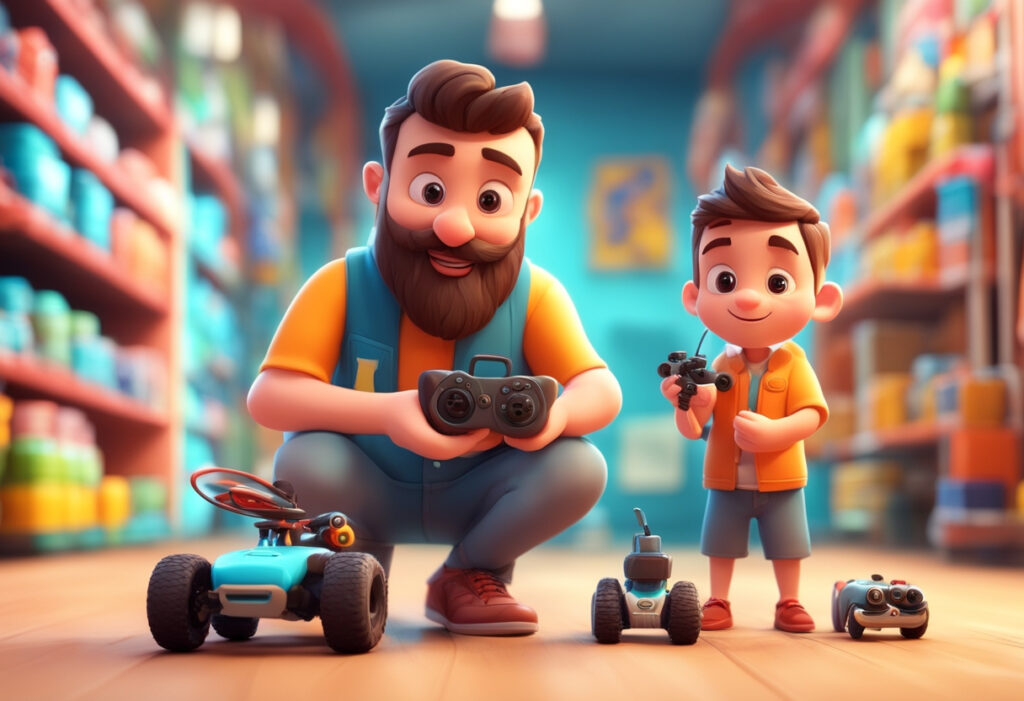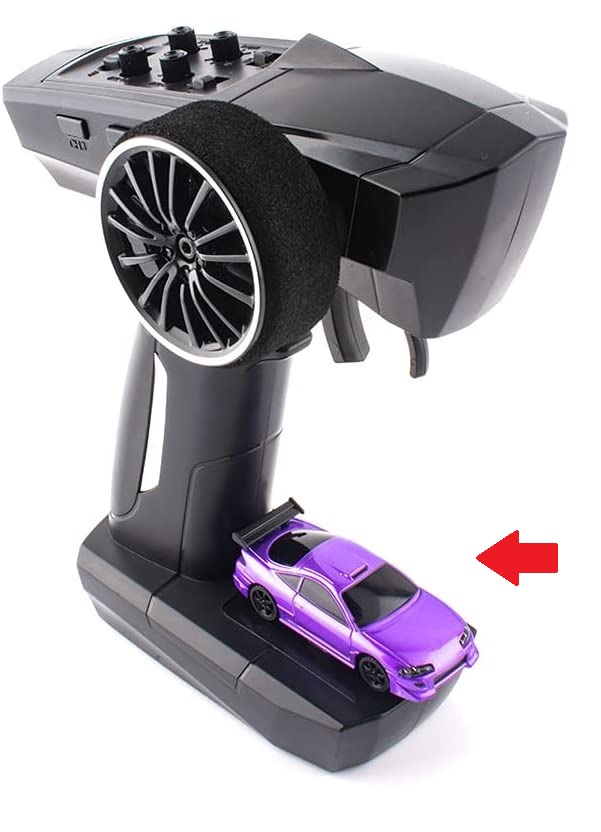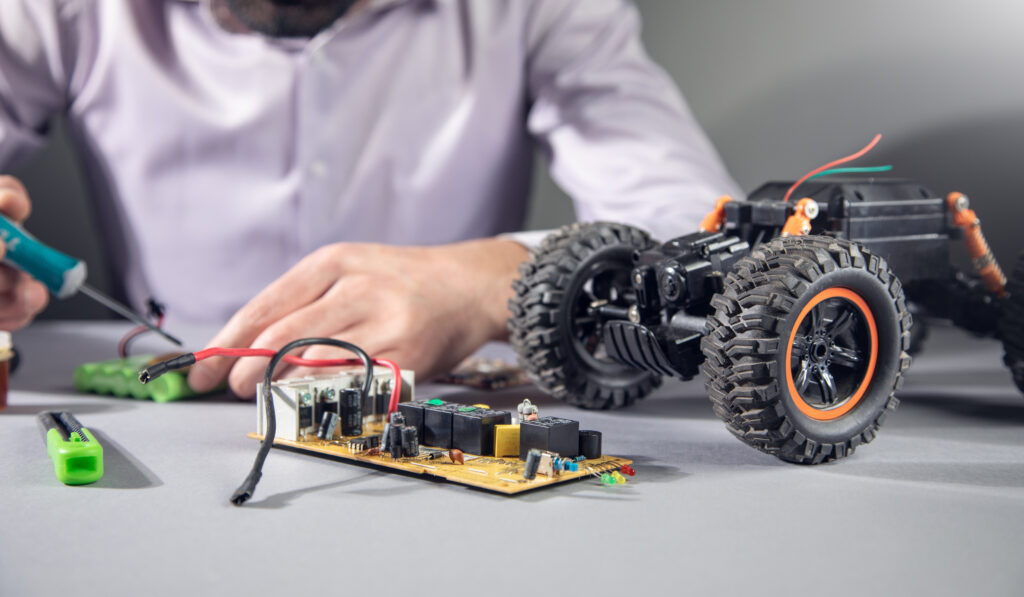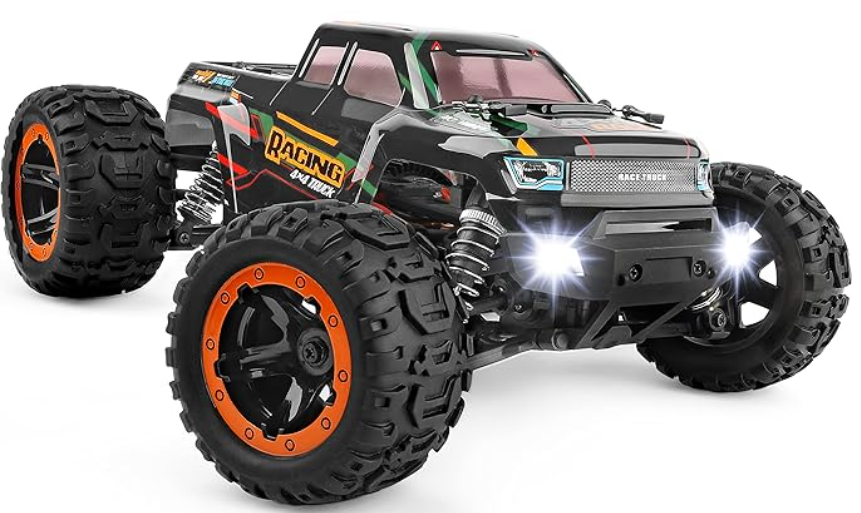
A Beginner’s Handbook to the World of Radio-controlled Toy Vehicles
If you’re thinking about getting an RC toy vehicle – car, boat, plane or any other – that can provide for lots of fun time with your kids, won’t cost a fortune, and doesn’t require expert skills, then read on…
I crafted this guide initially for myself because I was overwhelmed with all the options out there – the shapes and sizes, the “specs” and the range of prices.
Soon you’ll know enough to be able to navigate the world of RC toy vehicles with confidence and ease.
First, we’ll cover some basic RC terms and address beginner questions, and then I’ll give you some tips and suggestions to help kickstart your journey in the “RC world”.
I aimed to keep it concise, but there’s a lot to cover, so feel free to skim through. Notice the bolded and marked text — that’s where the key information lies.
Ready? Let’s begin with the very basics…
What Does “RC” Stand for?
In case you were wondering – is it “radio control” or “remote control” – the answer is: It depends. In most cases it means “radio control”, but there are other means of controlling devices from a distance, like Infrared (You may have seen those hand-gesture-controlled cars), or even wired (remember those?).
So for the most part it’s radio control, but let’s just call it RC 🙂
Size and Scale

There is a vast variety of sizes of RC toys, from “micro” (usually around 1/64 scale – ‘Hotweels size’) and up to huge 1/5 vehicles and even bigger…
In case you don’t know, a 1/10 scale means that it’s one-tenth the size of a similar real vehicle. A 1/32 model vehicle is 32 times smaller than its “original”.
This means that a 1/10 scale pick-up truck, for example, would be about 16in (40cm) in length.
The most common and popular RC toys are in the 1/32 to 1/10 scale range.
Each size can be great for its purpose, but also each size comes with its pros and cons.
For example, a small RC car (like a 1/32 scale ‘buggy’) might have trouble running on rugged surfaces, even on low grass.
Large RC vehicles can be cool and fun, but they usually cost more and can pose safety risks to people, pets, and property. They also need more space for play and storage. You get the idea.
Toy-grade vs Hobby-grade RC (vs Toby-grade…)
As you probably know or can guess, hobby-grade RC vehicles generally have higher performance, durability and… price.
In other words, they are faster, stronger (higher quality materials, metal parts, etc.) and of course more expensive than similar toy-grade ones. But there’s more to it…
Every hobbyist will tell you that the main difference is that hobby-grade RC vehicles are designed to be fixable and customizable.
Most if not all their parts can be replaced, they often have adjustable shocks, etc.

This also means that although hobby-grade RC vehicles are much more expensive – if they break, you can fix them, while toy-grade ones often end up in the trash.
Also, a hobby-grade RC vehicle will always have proportional controls, meaning that you can control the amount of throttle and steering, while in RC toys it’s usually kind-of an “on/off” switch control.
There’s also the middle-ground (which I tend to recommend to newbies) which some call “toby-grade”…
As you might guess these are somewhat higher-end RC toys. At the very least they have semi-proportional control and also are quite easy to upgrade by replacing a few parts.
They can offer lots of fun without breaking too fast, but also without the complexity of a hobby-grade vehicle.
This video covers these differences nicely (it talks about RC cars, but a lot of the difference points are quite similar in other types of vehicles as well):
If you feel like you’re ready to get more serious and jump up to a hobby RC car, check out this guide (on rctechtips.com) >>
RC Vehicle Specs – Simplified
Let’s simplify the basic technical specifications of RC vehicles to help you make the right choice when shopping for one.
We won’t be covering a lot of the RC hobby jargon. We won’t discuss “4 by 4 / 2 by 4”, suspension, servos, ESC (Electronic Speed Control. There, now you know), and other terms that are more for RC hobbyists.
We’ll cover just the most essential terms, to keep it short and simple.
Ready? Let’s go…
2.4GHz Radio Control
It’s the standard radio frequency for controlling RC vehicles today. Unless you want to delve into controllers and frequencies, that’s all you need to know.
Power Sources
Most RC vehicles are electric, but as you probably know, some are powered by fuel (nitro/gasoline) and there are even solar-powered ones.
Until not too long ago, nitro-powered RC vehicles were considered the go-to for serious hobbyists, but with today’s technology, electric ones are at least just as fast, without the noise, the smell, and the hassle. (Some hobbyists still swear by them though.)
If you’re after simplicity and ease of use, your best choice would be electric.
Brushless vs. Brushed Electronics

These are the 2 most common types of motors (and the electronic parts that go along with them) used in RC vehicles.
Generally the brushless are considered much more powerful and reliable, but they are also much more expensive.
Simply put, for beginners, Brushed can be more than fine.
RTR/RTF
RTR stands for Ready-to-Run (for most vehicles).
RTF stands for Ready-to-Fly (for aircraft).
In general, this implies that the vehicle is assembled and ready to play, inclusive of all necessary components. Simply connect the batteries, switch it on, and start ‘driving/flying.’
In contrast, hobby-grade RC vehicles typically come as a kit or in varying degrees of unreadiness. For instance, in aircraft, BNF means ‘Bind & Fly,’ indicating that it doesn’t come with a transmitter (controller).
Typically, RTRs are only 99% ready-to-run, because they lack the transmitter batteries (usually AAs or AAAs). Sometimes the package would be missing a charger or something else. It’s always wise to find out what’s included and what’s not.
If you’re new to the RC world and wish to keep things easy and simple, I highly recommend choosing Ready-to-Run (RTR) or Ready-to-Fly (RTF) models.
Battery Types

While some cheap RC toys still run on regular alkaline batteries (mostly AAs), nowadays, the majority of toy-grade RCs are powered by rechargeable ones.
The 3 most common types of batteries used to power RC vehicles are Nickel-Metal Hydride (NiMH), Lithium-ion (Li-ion), and Lithium Polymer (LiPo).
NiMH batteries are cost-effective and safer but are heavier and bulkier.
Li-ion batteries offer a balance between energy density and safety, while LiPo batteries provide high energy density and are lightweight, but demand careful handling, and may even combust in certain circumstances.
Therefore, at least at first, for your beginner RC vehicle, I recommend avoiding LIPO batteries and opting for either NIMH or Li-ion ones.
S2, S3…
In product descriptions, you may encounter terms like “‘S2 battery” or “S3 ready”. In this context, the ‘S’ signifies the Series, while the number represents the quantity of cells. The greater the number of cells “in the series,” the more potent the battery, resulting in increased speed for the RC vehicle”.
“S3 ready” implies that the electronic components are equipped to function with an S3 battery, but that it’s not included with the product.
There’s plenty more to say about batteries, but this will do for now.
(For more info about batteries you can visit RC hobby resources that do it well, like this article >> or this video >>).
How Fast Can RC Toy Vehicles Go?
Luckily, RC cars, boats, and planes generally have similar speeds, so we can talk about them all in one go.
Bear in mind, though, that high speed is not always the goal. For instance, there are “rock crawlers,” excavators, warships, etc. But when it comes to speed…
Most toy/toby-grade RC vehicles go as fast as 10-30 mph (15-50 km/h), while hobby-grade RC vehicles usually range from 50-100 mph (80-160 km/h).
Important note about speed:
Going fast is fun, obviously, but the faster you go the harder it is to handle the vehicle and the higher the chances of crashing or causing some type of damage, therefore we won’t necessarily try to get the fastest one possible.
Fun fact: In 2014, a custom-made electric RC car reached 325km/h (200mph), setting a Guinness World Record. (Watch the video)
RC Vehicles Price Ranges
Good quality ‘toby-grade’ RC vehicles typically fall within the $50-$150 range.
Below this range, you’re usually dealing with one-off toys often found at your local grocery store, which may end up in the trash within a week at most.
When it comes to hobby-grade RC vehicles, the range is much wider…
While the renowned Traxxas X-Maxx has a price tag of $1000 (not including battery and charger!), very basic models (from budget brands) start at about $150.
Of course, costs can increase significantly with spare parts, upgrades, accessories, etc. (especially when getting into RC racing…)
Choose Your 1st ‘Serious’ RC Vehicle
To sum things up, when choosing an RC vehicle, consider one that falls in the middle range. Seek a model that is reasonably priced, has a moderate size, and offers safety, ease of use, and versatility in play.
Aim for a ready-to-run (RTR) model with balanced speed and power—neither too fast nor too slow. Opt for an electric model with proportional controls, leaning towards a brushed motor and avoiding LIPO batteries.
Which RC “Vehicle Type” to Get?

There is a wide variety of RC toys, including land vehicles, watercraft, and aircraft (and also hybrids, like the drone/hovercraft (on Amazon) >>). Heck, there are even tanks, submarines, and whatnot.
Each type of RC toy can be lots of fun, but as you can imagine, watercraft and aircraft are generally less beginner-friendly. They are more difficult to control, and they are more limiting in terms of location and timing (weather, open space, etc.)
Did you know that in many countries, including the US, you need a license to fly model aircraft?
So if you ask me, your best choice for a 1st ‘serious’ RC vehicle should be a land vehicle.
- If you prefer an RC aircraft – go to the Beginner’s Guide to RC Aviation.
- Interested in RC boats? Check out the Amateur’s Guide to RC Boating.
When it comes to land vehicles, there are many options – from micro cars designed primarily for indoor play, all the way to farming vehicles and everything in between.
But my warm recommendation is this:
For a beginner-friendly, affordable, and reliable RC toy that will provide lots of outdoor (and indoor) fun with your kids, without breaking too soon and without needing to be an RC expert, go for a medium size (1/10 – 1/18 scale) ‘toby-grade’ off-road RC truck for 75$ to 150$USD.
Here’s a great option on the lower end (about $75USD):

The highly praised 1/16 scale RTR brushed RC “monster truck” Hailboxing Hailstorm (on Amazon) >>
Or – go pick from the best beginner RC trucks on Amazon >> (TIP: Use the left sidebar tools to narrow down your search, at least by price range.)
For more recommendations check out the 7 Budget-Friendly RC Cars & Trucks for Quality Dad Playtime

